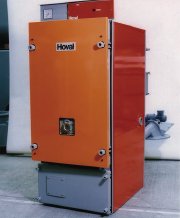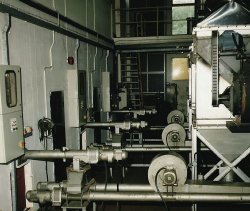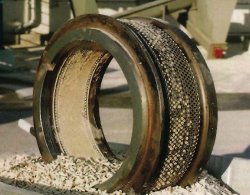Achieving carbon neutrality

Carbon neutral — modern wood-burning boilers such as Hoval’s STC range can achieve combustion efficiencies of up to 86%.
In the long term, any real policy of sustainability needs to include a move to fuels that do not deplete the world’s irreplaceable reserve of fossil fuels. IAN DAGLEY considers the benefits of wood as a carbon-neutral fuel.inding alternatives to the fossil fuels we are currently so dependent on is one of the biggest challenges facing the human race. In focusing on new technologies such as photo-voltaics and fuel cells, however, we may be neglecting the potential of the oldest fuel known to humanity — wood. Carbon neutral A big advantage of wood is that it is a virtually a carbon-neutral fuel. As trees grow, large amounts of carbon dioxide from the atmosphere are fixed during photosynthesis to create the matter of the tree — which we later burn. The net result is that the carbon dioxide produced by burning wood is equivalent to that absorbed by the tree in growth, making this fuel carbon-neutral. However, when calculating the overall carbon balance, it is important to include fossil fuels used in harvesting and transporting the wood. For this reason, wood-burning boilers need to be located close to the source of the wood to minimise collateral consumption of fossil fuel. That said, even the use of wood pellets imported from North America to satisfy space and hot water demands will much more than halve the carbon impact, compared to using fossil fuels. In response to the price constraints of conventional food crops, many farmers have switched to planting fast-growing crops such as willow and poplar, known as short-rotation coppice (SRC), and there are Government grants to encourage this. In addition, traditional coppicing has been re-introduced to many natural woodlands, and a market for the wood helps to fund the coppicing project. All of which means there are now many more local sources of wood for use in heating boilers. Burning wood Another very important consideration, though, is how efficiently the wood is burned, which is influenced by the design of the boiler and its controls, as well as the type of wood fuel that is used. Whereas early wood-burning boilers could only achieve efficiencies of around 50%, this has now increased to 90%, with a massive reduction in carbon monoxide emissions from 20 000 mg/m3 to 100 mg/m3.

Woodchips and pellets can be conveyed with a screw worm or augur for automatic feeding.

A major advantage of wood pellets as a boiler fuel is that their size is standardised, so they burn predictably and provide a consistent heat output.
It is also possible to achieve very high efficiencies by converting old coal-fired boilers to wood, as evidenced by a number of projects in Nottinghamshire, South Yorkshire and Leicestershire. Conversion is relatively straightforward, even with coal-fired boilers that are 25 years old. In most cases, little more is required than making improvements to the safety and position of the screw feed and increasing its speed, while decreasing the air mix to give combustion efficiencies of up to 86%. And this can be done with virtually any boiler up to 750 kW. Types of wood fuel Combustion efficiency, as well as cost and ease of use, are all related to the type of wood used. The three most commonly used types are logs, wood chips and wood pellets. Each has particular characteristics that need to be matched with the specific requirements of the application. In our experience, pellets offer the easiest solution for most projects. Modern log-burning boilers use a 2-stage combustion process. The first stage is gasification, followed by high-temperature combustion. They are reasonably efficient as long as the wood has been properly seasoned, but the fuel has to be handled manually and uses a lot of storage space. Both woodchips and pellets can be conveyed with a screw worm or augur for automatic feeding. Woodchips are produced by chipping or shredding various sources of wood, but most chips vary in size and moisture content so they require sophisticated and expensive boiler controls to handle the varying fuel properties. In addition, chips require more storage volume and more sophisticated handling equipment than pellets. Pellets are manufactured from sawdust, shavings and finely reduced wood waste, some of which comes from further processing of wood chips. A major advantage of pellets is that their size is standardised, so they burn predictably and provide a consistent heat output. Further, they have around 10% moisture content, considerably less than the 25 to 55% typical of chips, so that less energy is wasted boiling off water. This consistency of size also ensures trouble-free automatic feeding, as the pellets flow freely in the screw feeder. It also enables the pellets to be delivered by tanker and stored in a relatively small container, such as a silo. Wood remains the primary fuel for many developing countries. Because of its environmental, economic and social advantages, it is rapidly making a comeback in developed nations. It is now a serious contender for consideration in projects where efficiency needs to be combined with sustainability. Ian Dagley is with Hoval Ltd, Northgate, Newark, Notts NG24 1JN
Related links:






